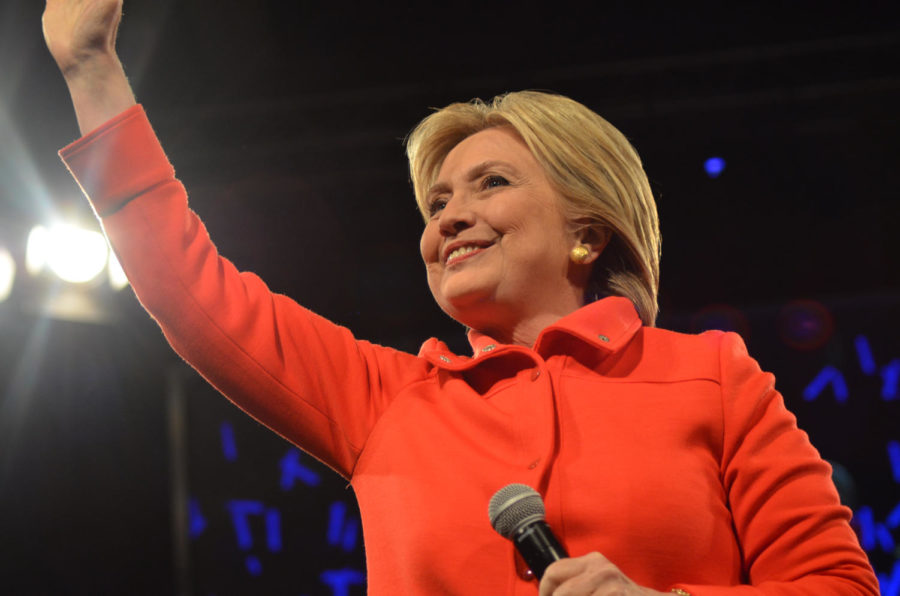Public appearance influences politics
Katy Klopfenstein/Iowa State Daily
Democratic presidential candidate Hillary Clinton appears at the Iowa Democratic Party’s annual Jefferson-Jackson Dinner in Des Moines on Saturday, Oct. 24.
November 10, 2015
Appearance can have an influence over individuals’ feelings, ideas and judgments of others. This rings true in politics as much as anywhere else.
The influence of appearance became evident after the first televised political debate in 1960. John F. Kennedy battled then-Vice President Richard Nixon, ending with an unclear winner. The difference came down to Kennedy’s decision to use makeup and Nixon’s sickly demeanor on camera, according to CBS News. This might have aided tin Kennedy’s ultimate victory that year.
A study conducted by MIT political scientists reveals that appearances of politicians does in fact impact people’s voting habits, leaning in favor of more attractive candidates without knowledge of their running platform.
Dianne Bystrom, director of the Carrie Chapman Catt Center for Women and Politics, has noticed a clear emphasis on women’s lookds throughout her studies of political coverage of both men and women since 1992.
“What you would typically find is women discussed in terms of their appearance,” Bystrom said. “They would comment on what they were wearing. They would comment on their hairstyle. They would comment … on their title.”
The year 1992 is known as the Year of the Woman, when more females ran and were elected to the Senate than ever before. The influx of female power lessened this emphasis on women’s looks and gave women a legitimate platform other than their outfit choice, Bystrom said.
“It has gotten a lot more equitable in some circumstances, for example … for men and women running for U.S. Senate or U.S. governor, but there’s still a lot of bias in [media] coverage,” Bystrom said.
The 2000s gave way for more topic-based content regarding all politicians, regardless of gender, especially in newspapers, Bystrom said. The appearance focus shifted to men more so than women during this time, somewhat equaling out the discrimination because of the progression of women in society, she said.
In 2000, Al Gore’s alpha male presence and dress were examined, along with John Edwards’ hair in 2008, Bystrom said. Men became more aware of their personal appearance and demeanor, spending more time grooming themselves for public appearances.
The statistics evened out, but the acceptable margins for men remain wider than those of women in the public eye. This grew evident in 1999 when Elizabeth Dole became the first woman to have a sustained campaign for presidential office.
“The big difference has been that these equities that occur with women running for U.S. Congress and governor don’t occur when a women is running for president,” Bystrom said.
According to The Atlantic, any “appearance coverage damages the voters’ perceptions of the woman candidate on all key traits.” The moment a woman running for a position of power is referred to in terms of beauty, whether in positive or negative terms, she is degraded to a lesser standard than her male contenders.
During Hillary Clinton’s 2008 candidacy, reporters were more concerned about her campaign strategy in relation to her clothes, hair, makeup and family life, according to Bystrom’s research. This gave her a disadvantage to her male counterparts because she had to give more attention to her appearance, taking away time from preparation and her view on the issues. Sarah Palin faced similar discrimination in comparison with running mate Joe Biden.
“People tend to like candidates that are attractive … but the standards might be higher for females,” Bystrom said. “[Voters] want women to be attractive but not too attractive.”
This creates a double-edged sword for women to balance that doesn’t affect men in the same perimeter. Women tend to play it safe and dress formal for advertisements and events, whereas men tend to have more flexibility with outfit choice, opting for jeans and a dress shirt.
The media’s general fixation on attractiveness and image regarding politicians of both sexes diminishes their platform stance and intellect, taking emphasis away from the real issues facing the nation.







